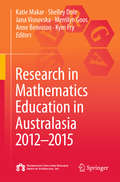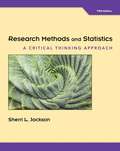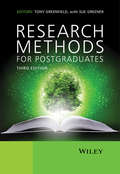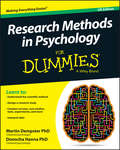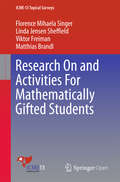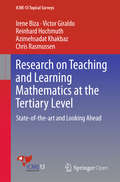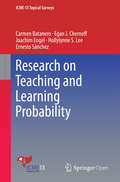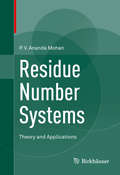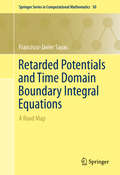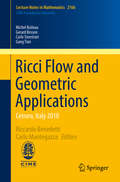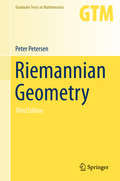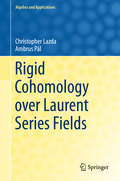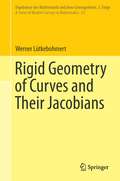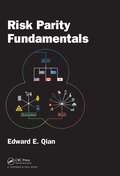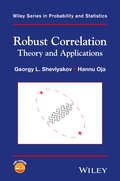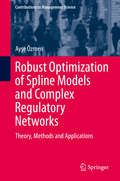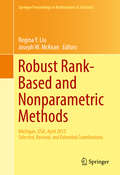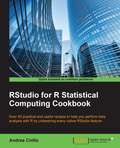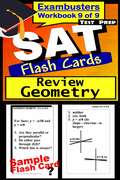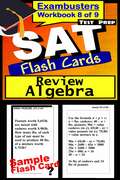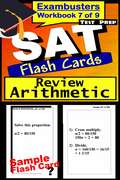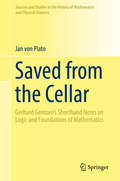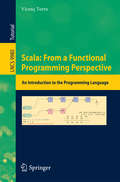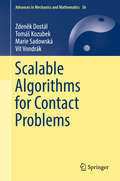- Table View
- List View
Research in Mathematics Education in Australasia 2012-2015
by Katie Makar Shelley Dole Jana Visnovska Merrilyn Goos Anne Bennison Kym FryWith the ninth edition of the four-yearly review of mathematics education research in Australasia, the Mathematics Education Research Group of Australasia (MERGA) discusses the Australasian research in mathematics education in the four years from 2012-2015. This review aims to critically promote quality research and focus on the building of research capacity in Australasia.
Research Methods and Statistics: A Critical Thinking Approach (5th Edition)
by Sherri L. JacksonRESEARCH METHODS AND STATISTICS: A CRITICAL THINKING APPROACH, 5th Edition, successfully illustrates the integration between statistics and research methods by demonstrating the ways to use statistics in analyzing data collected during research. Jackson's combined text adopts an inviting narrative style that speaks directly to students and draws them into the material, helping them overcome the initial apprehension they may feel at having to learn both subject areas at once. Focusing on the logic of the process and the methodology aspect of research, Jackson incorporates a student-friendly critical-thinking approach and presents examples and exercises to which students can relate.
Research Methods for Postgraduates
by Tony Greenfield Sue GreenerResearch Methods for Postgraduates brings together guidance for postgraduate students on how to organise, plan and do research from an interdisciplinary perspective. In this new edition, the already wide-ranging coverage is enhanced by the addition of new chapters on social media, evaluating the research process, Kansei engineering and medical research reporting. The extensive updates also provide the latest guidance on issues relevant to postgraduates in all subject areas, from writing a proposal and securing research funds, to data analysis and the presentation of research, through to intellectual property protection and career opportunities. This thoroughly revised new edition provides: Clear and concise advice from distinguished international researchers on how to plan, organise and conduct research. New chapters explore social media in research, evaluate the research process, Kansei engineering and discuss the reporting of medical research. Check lists and diagrams throughout.
Research Methods in Psychology For Dummies
by Donncha Hanna Martin DempsterYour hands-on introduction to research methods in psychology Looking for an easily accessible overview of research methods in psychology? This is the book for you! Whether you need to get ahead in class, you're pressed for time, or you just want a take on a topic that's not covered in your textbook, Research Methods in Psychology For Dummies has you covered. Written in plain English and packed with easy-to-follow instruction, this friendly guide takes the intimidation out of the subject and tackles the fundamentals of psychology research in a way that makes it approachable and comprehensible, no matter your background. Inside, you'll find expert coverage of qualitative and quantitative research methods, including surveys, case studies, laboratory observations, tests and experiments--and much more. Serves as an excellent supplement to course textbooks Provides a clear introduction to the scientific method Presents the methodologies and techniques used in psychology research Written by the authors of Psychology Statistics For Dummies If you're a first or second year psychology student and want to supplement your doorstop-sized psychology textbook--and boost your chances of scoring higher at exam time--this hands-on guide breaks down the subject into easily digestible bits and propels you towards success.
Research On and Activities For Mathematically Gifted Students (ICME-13 Monographs)
by Linda Jensen Sheffield Florence Mihaela Singer Viktor Freiman Matthias BrandlThis Topical Survey offers a brief overview of the current state of research on and activities for mathematically gifted students around the world. This is of interest to a broad readership, including educational researchers, research mathematicians, mathematics teachers, teacher educators, curriculum designers, doctoral students, and other stakeholders. It first discusses research concerning the nature of mathematical giftedness, including theoretical frameworks and methodologies that are helpful in identifying and/or creating mathematically gifted students, which is described in this section. It also focuses on research on and the development of mathematical talent and innovation in students, including connections between cognitive, social and affective aspects of mathematically gifted students. Exemplary teaching and learning practices, curricula and a variety of programs that contribute to the development of mathematical talent, gifts, and passion are described as well as the pedagogy and mathematics content suitable for educating pre-service and in-service teachers of mathematically gifted students. The final section provides a brief summary of the paper along with suggestions for the research, activities, and resources that should be available to support mathematically gifted students and their teachers, parents, and other stakeholders.
Research on Teaching and Learning Mathematics at the Tertiary Level
by Irene Biza Victor Giraldo Reinhard Hochmuth Azimeh Sadat Khakbaz Chris RasmussenThis topical survey focuses on research in tertiary mathematics education, a field that has experienced considerable growth over the last 10 years. Drawing on the most recent journal publications as well as the latest advances from recent high-quality conference proceedings, our review culls out the following five emergent areas of interest: mathematics teaching at the tertiary level; the role of mathematics in other disciplines; textbooks, assessment and students studying practices; transition to the tertiary level; and theoretical-methodological advances. We conclude the survey with a discussion of some potential directions for future research in this new and rapidly evolving domain of inquiry. "
Research on Teaching and Learning Probability
by Carmen Batanero Egan J. J. Chernoff Joachim Engel Hollylynne S. S. Lee Ernesto SánchezThis book summarizes the vast amount of research related to teaching and learning probability that has been conducted for more than 50 years in a variety of disciplines. It begins with a synthesis of the most important probability interpretations throughout history: intuitive, classical, frequentist, subjective, logical propensity and axiomatic views. It discusses their possible applications, philosophical problems, as well as their potential and the level of interest they enjoy at different educational levels. Next, the book describes the main features of probabilistic thinking and reasoning, including the contrast to classical logic, probability language features, the role of intuitions, as well as paradoxes and the relevance of modeling. It presents an analysis of the differences between conditioning and causation, the variability expression in data as a sum of random and causal variations, as well as those of probabilistic versus statistical thinking. This is followed by an analysis of probability s role and main presence in school curricula and an outline of the central expectations in recent curricular guidelines at the primary, secondary and high school level in several countries. This book classifies and discusses in detail the three different research periods on students and people s intuitions and difficulties concerning probability: early research focused on cognitive development, a period of heuristics and biases programs, and the current period marked by a multitude of foci, approaches and theoretical frameworks. "
Residue Number Systems
by P. V. Ananda MohanThis new and expanded monograph improves upon Mohan's earlier book, Residue Number Systems (Springer, 2002) with a state of the art treatment of the subject. Replete with detailed illustrations and helpful examples, this book covers a host of cutting edge topics such as the core function, the quotient function, new Chinese Remainder theorems, and large integer operations. It also features many significant applications to practical communication systems and cryptography such as FIR filters and elliptic curve cryptography. Starting with a comprehensive introduction to the basics and leading up to current research trends that are not yet widely distributed in other publications, this book will be of interest to both researchers and students alike.
Retarded Potentials and Time Domain Boundary Integral Equations
by Francisco-Javier SayasThis book offers a thoroughand self-contained exposition of the mathematics of time-domain boundaryintegral equations associated to the wave equation, including applications toscattering of acoustic and elastic waves. The book offers two differentapproaches for the analysis of these integral equations, including asystematic treatment of their numerical discretization using Galerkin(Boundary Element) methods in the space variables and ConvolutionQuadrature in the time variable. The first approach follows classical workstarted in the late eighties, based on Laplace transforms estimates. Thisapproach has been refined and made more accessible by tailoring thenecessary mathematical tools, avoiding an excess of generality. A secondapproach contains a novel point of view that the author and some of hiscollaborators have been developing in recent years, using the semigrouptheory of evolution equations to obtain improved results. The extension toelectromagnetic waves is explained in one of the appendices.
Ricci Flow and Geometric Applications
by Michel Boileau Gerard Besson Carlo Sinestrari Gang Tianriccardo Benedetti Carlo MantegazzaPresenting some impressive recent achievements in differential geometry and topology, this volume focuses on results obtained using techniques based on Ricci flow. These ideas are at the core of the study of differentiable manifolds. Several very important open problems and conjectures come from this area and the techniques described herein are used to face and solve some of them. The book's four chapters are based on lectures given by leading researchers in the field of geometric analysis and low-dimensional geometry/topology, respectively offering an introduction to: the differentiable sphere theorem (G. Besson), the geometrization of 3-manifolds (M. Boileau), the singularities of 3-dimensional Ricci flows (C. Sinestrari), and Kähler-Ricci flow (G. Tian). The lectures will be particularly valuable to young researchers interested in differential manifolds.
Riemann Surfaces and Algebraic Curves
by Renzo Cavalieri Eric MilesHurwitz theory, the study of analytic functions among Riemann surfaces, is a classical field and active research area in algebraic geometry. The subject's interplay between algebra, geometry, topology and analysis is a beautiful example of the interconnectedness of mathematics. This book introduces students to this increasingly important field, covering key topics such as manifolds, monodromy representations and the Hurwitz potential. Designed for undergraduate study, this classroom-tested text includes over 100 exercises to provide motivation for the reader. Also included are short essays by guest writers on how they use Hurwitz theory in their work, which ranges from string theory to non-Archimedean geometry. Whether used in a course or as a self-contained reference for graduate students, this book will provide an exciting glimpse at mathematics beyond the standard university classes.
Riemannian Geometry
by Peter PetersenIntended for a one year course, this text serves as a single source, introducing readers to the important techniques and theorems, while also containing enough background on advanced topics to appeal to those students wishing to specialize in Riemannian geometry. This is one of the few Works to combine both the geometric parts of Riemannian geometry and the analytic aspects of the theory. The book will appeal to a readership that have a basic knowledge of standard manifold theory, including tensors, forms, and Lie groups. Important revisions to the third edition include: a substantial addition of unique and enriching exercises scattered throughout the text; inclusion of an increased number of coordinate calculations of connection and curvature; addition of general formulas for curvature on Lie Groups and submersions; integration of variational calculus into the text allowing for an early treatment of the Sphere theorem using a proof by Berger; incorporation of several recent results about manifolds with positive curvature; presentation of a new simplifying approach to the Bochner technique for tensors with application to bound topological quantities with general lower curvature bounds. From reviews of the first edition: "The book can be highly recommended to all mathematicians who want to get a more profound idea about the most interesting achievements in Riemannian geometry. It is one of the few comprehensive sources of this type. " ―Bernd Wegner, ZbMATH
Rigid Cohomology over Laurent Series Fields
by Christopher Lazda Ambrus PálIn this monograph, the authors develop a new theory of p-adiccohomology for varieties over Laurent series fields in positive characteristic,based on Berthelot's theory of rigid cohomology. Many major fundamentalproperties of these cohomology groups are proven, such as finite dimensionalityand cohomological descent, as well asinterpretations in terms of Monsky-Washnitzer cohomology and Le Stum'soverconvergent site. Applications of this new theory to arithmetic questions, such as l-independenceand the weight monodromy conjecture, are also discussed. The construction of these cohomology groups, analogous to theGalois representations associated tovarieties over local fields in mixed characteristic, fills a major gap in the study of arithmetic cohomology theoriesover function fields. By extending the scope of existing methods, the results presented here also serve as a firststep towards a more general theory of p-adic cohomology overnon-perfect ground fields. Rigid Cohomology over Laurent Series Fields will provide a useful tool for anyone interested in thearithmetic of varieties over local fields of positive characteristic. Appendices on important background material such as rigid cohomology and adicspaces make it as self-contained as possible, and an ideal starting point forgraduate students looking to explore aspects of the classical theory of rigidcohomology and with an eye towards future research in the subject.
Rigid Geometry of Curves and Their Jacobians
by Werner LütkebohmertThis book presents some of the most important aspects of rigid geometry, namely its applications to the study of smooth algebraic curves, of their Jacobians, and of abelian varieties - all of them defined over a complete non-archimedean valued field. The text starts with a survey of the foundation of rigid geometry, and then focuses on a detailed treatment of the applications. In the case of curves with split rational reduction there is a complete analogue to the fascinating theory of Riemann surfaces. In the case of proper smooth group varieties the uniformization and the construction of abelian varieties are treated in detail. Rigid geometry was established by John Tate and was enriched by a formal algebraic approach launched by Michel Raynaud. It has proved as a means to illustrate the geometric ideas behind the abstract methods of formal algebraic geometry as used by Mumford and Faltings. This book should be of great use to students wishing to enter this field, as well as those already working in it.
Risk Parity Fundamentals
by Edward E. QianWritten by an experienced researcher and portfolio manager who coined the term "risk parity," this book provides readers with a practical understanding of the risk parity investment approach. It uses fundamental, quantitative, and historical analysis to address the merit of risk parity as well as the practical and underlying aspects of risk parity investing. Requiring no advanced degrees in quantitative fields, the book analyzes risk parity performance from historical periods and more recent market environments.
Robust Correlation: Theory and Applications
by Hannu Oja Georgy L. ShevlyakovThis bookpresents material on both the analysis of the classical concepts of correlation and on the development of their robust versions, as well as discussing the related concepts of correlation matrices, partial correlation, canonical correlation, rank correlations, with the corresponding robust and non-robust estimation procedures. Every chapter contains a set of examples with simulated and real-life data. Key features: Makes modern and robust correlation methods readily available and understandable to practitioners, specialists, and consultants working in various fields. Focuses on implementation of methodology and application of robust correlation with R. Introduces the main approaches in robust statistics, such as Huber's minimax approach and Hampel's approach based on influence functions. Explores various robust estimates of the correlation coefficient including the minimax variance and bias estimates as well as the most B- and V-robust estimates. Contains applications of robust correlation methods to exploratory data analysis, multivariate statistics, statistics of time series, and to real-life data. Includes an accompanying website featuring computer code and datasets Features exercises and examples throughout the text using both small and large data sets. Theoretical and applied statisticians, specialists in multivariate statistics, robust statistics, robust time series analysis, data analysis and signal processing will benefit from this book. Practitioners who use correlation based methods in their work as well as postgraduate students in statistics will also find this book useful.
Robust Optimization of Spline Models and Complex Regulatory Networks
by Ayşe ÖzmenThis book introduces methods of robust optimization in multivariateadaptive regression splines (MARS) and Conic MARS in order to handleuncertainty and non-linearity. The proposed techniques are implemented andexplained in two-model regulatory systems that can be found in the financialsector and in the contexts of banking, environmental protection, system biologyand medicine. The book provides necessarybackground information on multi-model regulatory networks, optimizationand regression. It presents the theory of and approaches to robust (conic)multivariate adaptive regression splines - R(C)MARS - and robust (conic)generalized partial linear models - R(C)GPLM - under polyhedral uncertainty. Further,it introduces spline regression models for multi-model regulatory networks andinterprets (C)MARS results based on different datasets for the implementation. It explains robust optimization in these models in terms of both the theory andmethodology. In this context it studies R(C)MARS results with differentuncertainty scenarios for a numerical example. Lastly, the book demonstratesthe implementation of the method in a number of applications from thefinancial, energy, and environmental sectors, and provides an outlook on futureresearch.
Robust Rank-Based and Nonparametric Methods
by Regina Y. Liu Joseph W. MckeanThe contributors to this volume include many of the distinguished researchers in this area. Many of these scholars have collaborated with Joseph McKean to develop underlying theory for these methods, obtain small sample corrections, and develop efficient algorithms for their computation. The papers cover the scope of the area, including robust nonparametric rank-based procedures through Bayesian and big data rank-based analyses. Areas of application include biostatistics and spatial areas. Over the last 30 years, robust rank-based and nonparametric methods have developed considerably. These procedures generalize traditional Wilcoxon-type methods for one- and two-sample location problems. Research into these procedures has culminated in complete analyses for many of the models used in practice including linear, generalized linear, mixed, and nonlinear models. Settings are both multivariate and univariate. With the development of R packages in these areas, computation of these procedures is easily shared with readers and implemented. This book is developed from the International Conference on Robust Rank-Based and Nonparametric Methods, held at Western Michigan University in April 2015.
RStudio for R Statistical Computing Cookbook
by Andrea CirilloOver 50 practical and useful recipes to help you perform data analysis with R by unleashing every native RStudio feature About This Book * 54 useful and practical tasks to improve working systems * Includes optimizing performance and reliability or uptime, reporting, system management tools, interfacing to standard data ports, and so on * Offers 10-15 real-life, practical improvements for each user type Who This Book Is For This book is targeted at R statisticians, data scientists, and R programmers. Readers with R experience who are looking to take the plunge into statistical computing will find this Cookbook particularly indispensable. What You Will Learn * Familiarize yourself with the latest advanced R console features * Create advanced and interactive graphics * Manage your R project and project files effectively * Perform reproducible statistical analyses in your R projects * Use RStudio to design predictive models for a specific domain-based application * Use RStudio to effectively communicate your analyses results and even publish them to a blog * Put yourself on the frontiers of data science and data monetization in R with all the tools that are needed to effectively communicate your results and even transform your work into a data product In Detail The requirement of handling complex datasets, performing unprecedented statistical analysis, and providing real-time visualizations to businesses has concerned statisticians and analysts across the globe. RStudio is a useful and powerful tool for statistical analysis that harnesses the power of R for computational statistics, visualization, and data science, in an integrated development environment. This book is a collection of recipes that will help you learn and understand RStudio features so that you can effectively perform statistical analysis and reporting, code editing, and R development. The first few chapters will teach you how to set up your own data analysis project in RStudio, acquire data from different data sources, and manipulate and clean data for analysis and visualization purposes. You'll get hands-on with various data visualization methods using ggplot2, and you will create interactive and multidimensional visualizations with D3.js. Additional recipes will help you optimize your code; implement various statistical models to manage large datasets; perform text analysis and predictive analysis; and master time series analysis, machine learning, forecasting; and so on. In the final few chapters, you'll learn how to create reports from your analytical application with the full range of static and dynamic reporting tools that are available in RStudio so that you can effectively communicate results and even transform them into interactive web applications. Style and approach RStudio is an open source Integrated Development Environment (IDE) for the R platform. The R programming language is used for statistical computing and graphics, which RStudio facilitates and enhances through its integrated environment. This Cookbook will help you learn to write better R code using the advanced features of the R programming language using RStudio. Readers will learn advanced R techniques to compute the language and control object evaluation within R functions. Some of the contents are: * Accessing an API with R * Substituting missing values by interpolation * Performing data filtering activities * R Statistical implementation for Geospatial data * Developing shiny add-ins to expand RStudio functionalities * Using GitHub with RStudio * Modelling a recommendation engine with R * Using R Markdown for static and dynamic reporting * Curating a blog through RStudio * Advanced statistical modelling with R and RStudio
SAT Test Prep Flash Cards: Geometry Review (Exambusters SAT Workbook #9 of 9)
by Ace Inc.<P><P><i>Advisory: Bookshare has learned that this book offers only partial accessibility. We have kept it in the collection because it is useful for some of our members. Benetech is actively working on projects to improve accessibility issues such as these.</i><P><P> 450 questions and answers that focus on essential geometry theorems, postulates, concepts, and definitions. Includes complementary diagrams. <P><P>Topics: Lines and Angles, Triangles, Proofs, Perpendicular Lines, Parallel Lines, Angle Sums, Quadrilaterals, Medians, Altitudes and Bisectors, Circles, Ratio and Proportion, Similar Polygons, Circles and Regular Polygons, Coordinate Geometry<P> EXAMBUSTERS SAT Prep Workbooks provide comprehensive, fundamental SAT review--one fact at a time--to prepare students to take practice SAT tests. Each SAT study guide focuses on one specific subject area covered on the SAT exam. From 300 to 600 questions and answers, each volume in the SAT series is a quick and easy, focused read. Reviewing SAT flash cards is the first step toward more confident SAT preparation and ultimately, higher SAT exam scores!
SAT Test Prep Flash Cards: Algebra Review (Exambusters SAT Workbook #8 of 9)
by Ace Inc.<P><P><i>Advisory: Bookshare has learned that this book offers only partial accessibility. We have kept it in the collection because it is useful for some of our members. Benetech is actively working on projects to improve accessibility issues such as these.</i><P><P> 450 questions and answers that highlight introductory algebra definitions, problems, and concepts. <P><P>Topics: Algebraic Concepts, Sets, Variables, Exponents, Properties of Numbers, Simple Equations, Signed Numbers, Monomials, Polynomials, Additive and Multiplicative Inverse, Word Problems, Prime Numbers, Factoring, Algebraic Fractions, Ratio and Proportion, Variation, Radicals, Quadratic Equations <P>EXAMBUSTERS SAT Prep Workbooks provide comprehensive, fundamental SAT review--one fact at a time--to prepare students to take practice SAT tests. Each SAT study guide focuses on one specific subject area covered on the SAT exam. From 300 to 600 questions and answers, each volume in the SAT series is a quick and easy, focused read. Reviewing SAT flash cards is the first step toward more confident SAT preparation and ultimately, higher SAT exam scores!
SAT Test Prep Flash Cards: Arithmetic Review (Exambusters SAT Workbook #7 of 9)
by Ace Inc.P><P><i>Advisory: Bookshare has learned that this book offers only partial accessibility. We have kept it in the collection because it is useful for some of our members. Benetech is actively working on projects to improve accessibility issues such as these.</i><P><P> 600 questions and answers highlight essential arithmetic definitions, problems, and concepts. <P><P>Topics: Addition, Subtraction, Multiplication, and Division of Whole Numbers; Fractions and Decimals, Multiplication Tables, Word Problems, Percents, Measurement, Metric System, Square Roots and Powers, Real Numbers, Properties of Numbers <P> EXAMBUSTERS SAT Prep Workbooks provide comprehensive, fundamental SAT review--one fact at a time--to prepare students to take practice SAT tests. Each SAT study guide focuses on one specific subject area covered on the SAT exam. From 300 to 600 questions and answers, each volume in the SAT series is a quick and easy, focused read. Reviewing SAT flash cards is the first step toward more confident SAT preparation and ultimately, higher SAT exam scores!
Saved from the Cellar
by Jan Von PlatoGerhard Gentzen is best known for his development of the proof systems of natural deduction and sequent calculus, central in many areas of logic and computer science today. Another noteworthy achievement is his resolution of the embarrassing situation created by Gödel's incompleteness results, especially the second one about the unprovability of consistency of elementary arithmetic. After these successes, Gentzen dedicated the rest of his short life to the main problem of Hilbert's proof theory, the question of the consistency of analysis. He was arrested in the summer of 1945 with other professors of the German University of Prague and died soon afterward of starvation in a prison cell. Attempts at locating his lost manuscripts failed at the time, but several decades later, two slim folders of shorthand notes were found. In this volume, Jan von Plato gives an overview of Gentzen's life and scientific achievements, based on detailed archival and systematic studies, and essential for placing the translations of shorthand manuscripts that follow in the right setting. The materials in this book are singular in the way they show the birth and development of Gentzen's central ideas and results, sometimes in a well-developed form, and other times as flashes into the anatomy of the workings of a unique mind.
Scala: From a Functional Programming Perspective
by Vicenç TorraThis book gives an introduction to the programming language Scala. It presents it from a functional programming perspective. The book explains with detail functional programming and recursivity, and includes chapters on lazy and eager evaluation, streams, higher-order functions (including map, fold, reduce, and aggregate), and algebraic data types. The book also describes the object-oriented aspects of Scala, as they are a fundamental part of the language. In addition, the book includes a chapter on parallelism in Scala, giving an overview of the actor model.
Scalable Algorithms for Contact Problems (Advances in Mechanics and Mathematics #36)
by Zdeněk Dostál Tomáš Kozubek Marie Sadowská Vít VondrákThis book presents a comprehensive and self-contained treatment of the authors’ newly developed scalable algorithms for the solutions of multibody contact problems of linear elasticity. The brand new feature of these algorithms is theoretically supported numerical scalability and parallel scalability demonstrated on problems discretized by billions of degrees of freedom. The theory supports solving multibody frictionless contact problems, contact problems with possibly orthotropic Tresca’s friction, and transient contact problems. It covers BEM discretization, jumping coefficients, floating bodies, mortar non-penetration conditions, etc. The exposition is divided into four parts, the first of which reviews appropriate facets of linear algebra, optimization, and analysis. The most important algorithms and optimality results are presented in the third part of the volume. The presentation is complete, including continuous formulation, discretization, decomposition, optimality results, and numerical experiments. The final part includes extensions to contact shape optimization, plasticity, and HPC implementation. Graduate students and researchers in mechanical engineering, computational engineering, and applied mathematics, will find this book of great value and interest.
